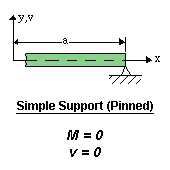Based on the moment-curvature relationship, the governing differential equation for the deflection of an elastic beam, for small deflections:
EI is called the bending stiffness or flexural rigidity of a beam. v''(x) is the curvature of the beam at position x.

Mouse-over image to see description
Expressions for slope v'(x) and beam deflection v(x) are determined by integrating twice:
Curvature |
|
Slope |
|
Deflection |
Constants C1 and C2 are determined by considering the beam's geometric boundary conditions.
